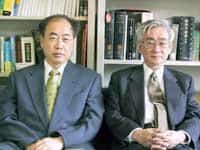
Much to the delight of particle physicists, this year’s Nobel Prize for Physics has been shared among three chief architects of the Standard Model.
The Nobel committee has awarded one half of the 10 million kronor (£800,000) prize to Yoichiro Nambu of the University of Chicago in the US “for the discovery of the mechanism of spontaneous broken symmetry in subatomic physics.”
Meanwhile, the committee has awarded the other half jointly to Makoto Kobayashi of the KEK lab and Toshihide Maskawa of the Yukawa Institute for Theoretical Physics, both in Japan, “for the discovery of the origin of the broken symmetry which predicts the existence of at least three families of quarks in nature.”
Nambu’s work is a cornerstone of the Standard Model Tim Gershon, University of Warwick
Breaking symmetry
Physicists know that, besides energy, “stuff” in the universe comes in two forms: matter and antimatter. The Big Bang should have created equal amounts of both, but the universe of today appears to be dominated by matter. Symmetry breaking — a key concept in particle physics — seeks to explain the subtle differences in physics that enabled normal matter to tip the balance.
The first suggestion of a way in which the symmetry of matter and antimatter could be broken came in 1956 from Chen Ning Yang of Chicago University and Tsung Dao Lee of Columbia University. They proposed that mirror or “parity” symmetry — one of the three fundamental symmetries of nature — might break in the weak force. Experiments on the decay of cobalt atoms swiftly verified their belief while marking them down for the Nobel prize a year later.
Despite this proof that symmetries could at least be broken individually, most assumed that combined parity and charge symmetry, or so-called CP symmetry, would hold. But in 1964 tests on the radioactive decay of particles known as kaons showed that even CP symmetry could break, a result that won physicists James Cronin and Val Fitch the Nobel prize in 1980.
CKM matrix
It is the theory that explains this broken symmetry that has handed the 2008 prize to Maskawa and Kobayashi. In 1972, using calculations based on quantum mechanics, the Japanese researchers — following the concept of “quark mixing” proposed by Italian physicist Nicola Cabibbo — formulated the 3 × 3 “CKM” matrix that describes how the strange quark and anti–down quark inside a kaon can change flavour into an anti-strange quark and a down quark. Moreover, the CKM matrix predicted another third family of quarks, all of which were discovered over the following three decades.
Nambu’s work focuses on “spontaneous” symmetry violation, which describes how unstable, symmetrical systems can suddenly turn unsymmetrical. In 1960, Nambu was working on how spontaneous symmetry violation can cause substances to become superconducting when he discovered that the principle could also be extended to particle physics.
The importance of Nambu’s work becomes apparent when one considers that it underpins the mechanism for the Higgs boson — the particle that will likely be discovered at the Large Hadron Collider (LHC) in Europe after the machine begins taking data next year. Sometime in the very early universe, spontaneous symmetry violation caused the field of the Higgs boson to lose its symmetry, which is why all particles today have different masses.
At a stroke, Kobayashi and Maskawa predicted a mechanism extending the Standard Model to accommodate the matter–antimatter asymmetry Paul Harrison, University of Warwick
‘Astonishing insight’
Tim Gershon of the University of Warwick in the UK says he is “thrilled” at the recognition of the three particle physicists. “Nambu’s work is a cornerstone of the Standard Model,” he explains. “With results from the LHC expected in the next few years, [the award] provides a timely reminder of the crucial insights into nature provided by Nambu.”
Gershon adds that the 1972 work of Maskawa and Kobayashi was an “astonishing insight”. “I would say that such a predictive theory is physics of the very best kind, and highly deserving of the Nobel Prize,” he continues. “The award also serves as recognition of the many theoretical and experimental physicists who have worked towards the successful tests of their theory — they are of course too many to name, or award prizes to, but they deserve at least a drink in celebration.”
Paul Harrison, also at Warwick, agrees that the awards are well-deserved. “At a stroke, Kobayashi and Maskawa predicted a mechanism extending the Standard Model to accommodate the matter–antimatter asymmetry, and predicted two new particles that together added five new fundamental constants to the laws of nature. It’s great news for flavour physics.”




